With an EFI-Fed 440, this 1971 Barracuda was built to drive
The Perfect Solution
09/12/2022

The Perfect Solution

Mike Hernden's 1970 GTX was a stunner. It was a local-area car since new, with its original 440+6 engine, and he’d lusted after it for ages. After 39 years with the B-body, and much persistent nudging, the owner finally relented and sold the car to Mike. "It was an amazing-looking car, in Tor-Red with white stripes and a white interior," he says. "And it was original, right down to the carburetors, but it needed a restoration."
Mike spent the next four years on the painstaking project, ensuring every last fastener was fastidiously fawned over in his quest to make the GTX as correct as possible. The work paid off, as the car drew plenty of rewarding attention from aficionados who assumed it was a professional job.
"It was satisfying, because I knew I’d done virtually everything on it myself," he says. "I always wanted a perfect, all-correct muscle car and the GTX was it."
There’s a "but" to that sentiment, however, and Mike says it was the age-old philosophical dilemma of having a car so perfect that he and his wife, Jamie, didn’t drive it. They had a fine time displaying it at shows but didn’t take it on long-distance trips — something they’d been wanting to do with a muscle car for years.

"You’re kind of in a box with a perfectly restored car," Mike says. "We were looking for something outside of that box. Something with a bit more freedom to drive."
The solution showed up about five years ago at the paint shop that resprayed his GTX. It was a 1971 Plymouth Barracuda that had been to virtually every corner of the country, with a number of owners who’d systematically restored and "restified" the car, changing its original brown-over-brown color combination to Sassy Grass green over black, and swapping its original 318 V-8 for a 440.
It was also far from perfect. The wiring was a mess and mostly missing, according to Mike, and the engine was weak, thanks to a wiped-out mechanical camshaft. The ‘Cuda was shop owner Keith Smith’s project; in a trade-out for some of the work on his GTX, Mike agreed to help with the ‘Cuda’s engine work. It also had its air conditioning removed, a process that included swapping the dashboard to a non-A/C version and even cutting out part of the firewall and replacing the section with one from a non-A/C donor body.

The paint, however, which wore the iconic billboard stripes, was in surprisingly strong condition, considering it had been sprayed in 2002. After about of a week of color-sanding and buffing, the Sassy Grass green gleamed in the sunlight. It was shortly thereafter, in 2018, that the shop owner, Keith Smith, decided to part with the ‘Cuda.
"He told me that he was going to list it on eBay, and I told him not to bother, because it was already sold," Mike says. "With the car being far from original, I knew it was exactly what my wife and I wanted for a restomod driver. It would just be a matter of making it really ours."
For their long-hauling ambitions, drivability was a priority, and for that Mike took the plunge by adding an electronically controlled fuel-injection system on the 440.
"I wanted the tuning control that came with it," he says. "That was the overall goal, but I also wanted the look of multiple carbs, because all of my Mopars have had them."
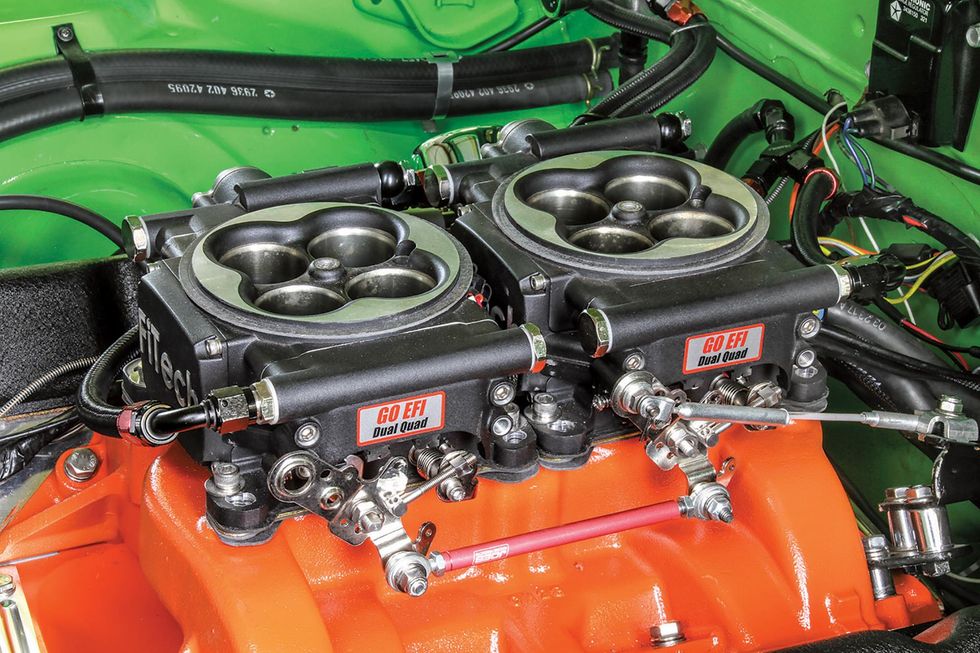
Mike found it with FiTech EFI’s 2x4 setup, which used a pair of throttle bodies that had the classic look of dual quads when mounted on an Edelbrock CH-28 440 dual-quad intake manifold. In fact, their installed position on the intake allowed the use of a factory Shaker hood scoop assembly without any modifications.
"I used the Hemi base and was thrilled when it all fit perfectly," Mike says. "The only thing I did was add a couple of spacers on top of the throttle bodies to get the height of the Shaker just right."
Mike says he was also surprised by the relative ease in the injection system’s self-learning setup and additional fine-tuning. In a nutshell, one of the throttle bodies worked as the brains of the operation, while the other added four additional injectors and the Idle Air Control motor for idle stability. Another key to its success, he notes, was the investment in a properly baffled fuel tank and in-tank high-pressure fuel pump.
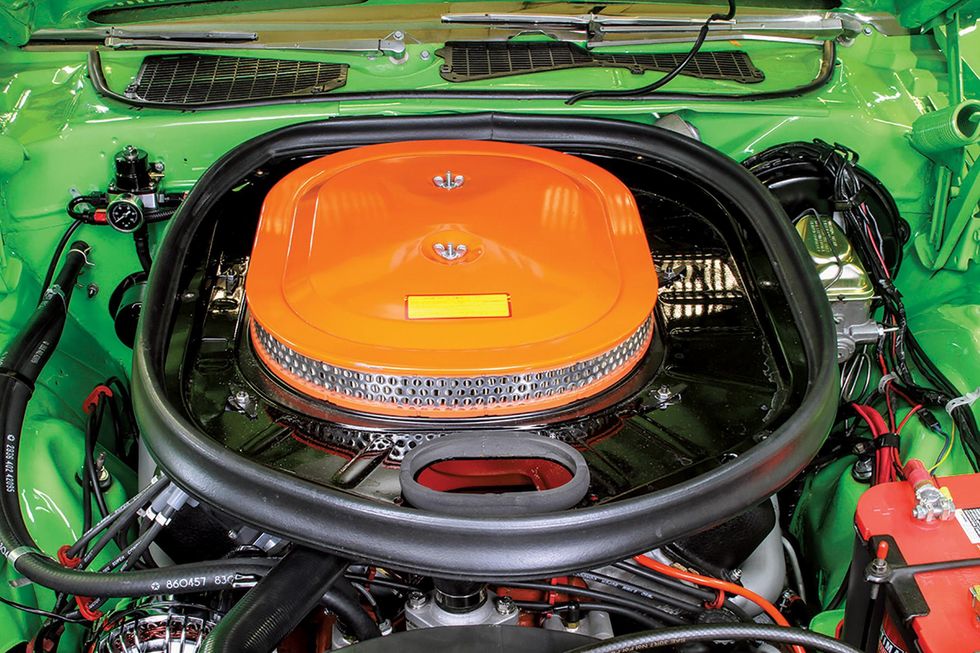
"You’ll hear all sorts of opinions about this system. If you take the time to learn how to not only make tuning adjustments, but to also save and store them properly with the controller, it’s really quite easy," he says. "I think it’s a really good system, and it’s never given me any issues after we got the tune sorted."
Perhaps the biggest endorsement came from Mike’s longtime cruising companion.
"Jamie told me, ‘I can roll down the window now and not taste gasoline," he says. "And if she’s happy, I’m happy. The drivability with the injection system is really great. It’s just what we were looking for."

Beneath the induction setup, the engine has a stock-spec 440+6 steel crankshaft and rods, along with 0.030- over TRW pistons. Mike also added high-flow Edelbrock aluminum heads and a roller camshaft to complement the anticipated capability with the new induction system. He also capped off the build with TTI step headers that flow into a TTI 3-inch exhaust system (with X-pipe). Electronic exhaust cutouts turn the engine’s grumble into a snarl at the push of a button.
Mike estimates his fuel-injected 440 is putting out about 575 horsepower and 550 lb-ft of torque, and revs willingly to 6,500 rpm. And because RB engines are known to run warm, especially when modified, the standard water pump was changed to a FlowKooler pump to keep the heat under control. Its identifying feature is a 16-vane billet-aluminum impeller that greatly enhances coolant flow.
"It really moves the water!" Mike says. "It’s an absolute must with these engines. With a big, thick aluminum radiator, this engine has never topped 180 degrees."
That’s another notch in favor of the car’s desired drivability, and Mike says he’s contemplating an overdrive conversion for the A833 four-speed manual gearbox backing the 440 — this will bring down the highway cruising rpm, which, ultimately, would be easier on the engine, not to mention the fuel tab on long drives.
Mike reports that it’s not too bad at the moment: 2,600 rpm at 75 mph with a 3.54-geared Dana 60. The engine would tach even higher on the highway, however, if it weren’t for strategically sized 28-inch-tall rear drag radials.
"Many people go with shorter tires, especially with larger-diameter wheels, but that just works against them on the highway, when you don’t have overdrive," Mike says. "It’s like installing an even shorter gear ratio."

Mike says he tried multiple tire sizes on his Barracuda, evaluating three or four sets until they filled the fenders just right. The car rolls on 17-inch modern Rallye wheels from Year One, and the trick with them, he says, was finding tires with sufficient sidewall height. In the front, they’re sized 245/45R17 and in the rear, they’re 275/50R18.
Yes, those are pretty wide rear treads for an E-body with stock wheelhouses, but the Dana 60 on which they’re hung is the narrower 52-inch-wide axle from a B-body rather than the E-body’s 54-inch axle. That pulled the wheels in, enabling more room for the wider tires, and the effect works very well. Other chassis and suspension upgrades done to support the car’s performance capability include proper big-block torsion bars in front and Hemi-spec leaf springs in the rear.
Inside, the car’s black vinyl cabin is mostly stock-appearing, with white-face gauges, a trio of aftermarket instruments that supplement the less-than-specific readouts of the originals, and a replacement radio being the only standout deviations from stock. There’s also a display screen for the FiTech EFI control system.

It’s a clean cruising environment, but Mike notes a couple of "honey do" items to tackle before his wife is ready for a cross-country drive.
"She wants air conditioning in the car, which is ironic, because a lot of work went into eliminating all the A/C-related components," he says with a sigh. "But we’ll add it. That and some more comfortable seats for the long hauls."
Those projects haven’t kept the couple from already hitting the road; they’ve been busy racking up miles to events throughout their home state of Michigan. The car’s Sassy Grass green color and billboard stripes draw plenty of attention, while the "dual-quad" fuel injection system triggers more than its share of questions and debate.
"Yes, there are some purists who are still uncomfortable with a restomod like this, but the car strayed from original long before I bought it," Mike says. "The bottom line is that it wasn’t built to satisfy anyone but my wife and me. It was built to drive and that’s just what we plan to do with it for the next few years."
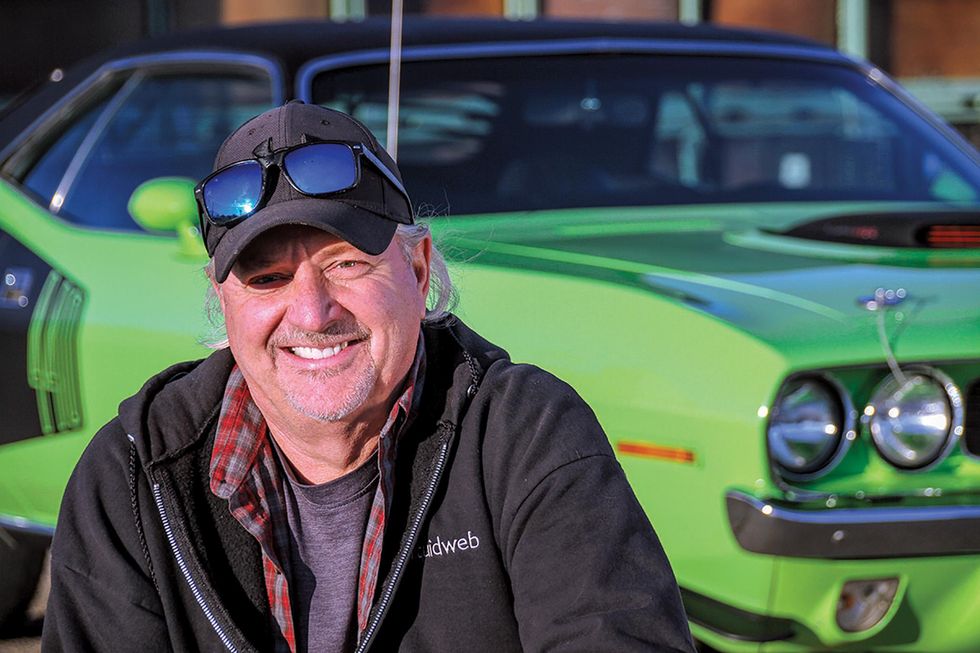
OWNER'S VIEW
I’ve been a Mopar guy my whole life. My first car was a 1969 Dodge that I transformed into a Super Bee, and over the years, I’ve done it all: modified street cars, drag racing, restored muscle cars. All of it. This Barracuda provided the opportunity to build something really creative that my wife and I could enjoy more than anything else I’ve built. There are still a couple of things we want to do with it, but it’s exactly the car we’ve wanted, and we couldn’t be happier with the results. —Mike Hernden
SPECIFICATIONS--1971 PLYMOUTH BARRACUDA
ENGINE
Block type: Chrysler RB-series "big-block" OHV V-8, cast-iron block, Edelbrock Performer RPM (aluminum) cylinder heads
Displacement: 446-cu.in.
Bore x stroke: 4.350 x 3.750 in
Compression ratio: 10.5:1
Horsepower @ rpm: 575 (est.)
Torque @ rpm: 550 lb-ft (est.)
Valvetrain: Lunati hydraulic roller lifters and Hughes Racing aluminum roller rocker arms
Camshaft: Edelbrock Rollin’ Thunder hydraulic roller
Induction: FiTech EFI 2x4-style throttle bodies mounted on Edelbrock CH-28 440 aluminum 2x4 intake manifold
Lubrication system: Milodon billet oil pump
Ignition system: MSD Pro-Billet distributor (electronic)
Exhaust system: TTI stepped headers (2-in. to 2-1/8-in), with TTI 3-in exhaust system (incl. X-pipe) and Badlanz electronic exhaust cutouts
TRANSMISSION
Type: Chrysler A833 four-speed manual (18-spline)
Ratios: 1st/2.65:1 … 2nd/1.93:1 … 3rd/1.39:1 … 4th/1.00:1 … 5th/0.82:1 … Reverse/2.56:1
DIFFERENTIAL
Type: Dana 60 9.75-in with Power-Loc limited-slip (with B-body 52-in housing width)
Ratio: 3.54:1
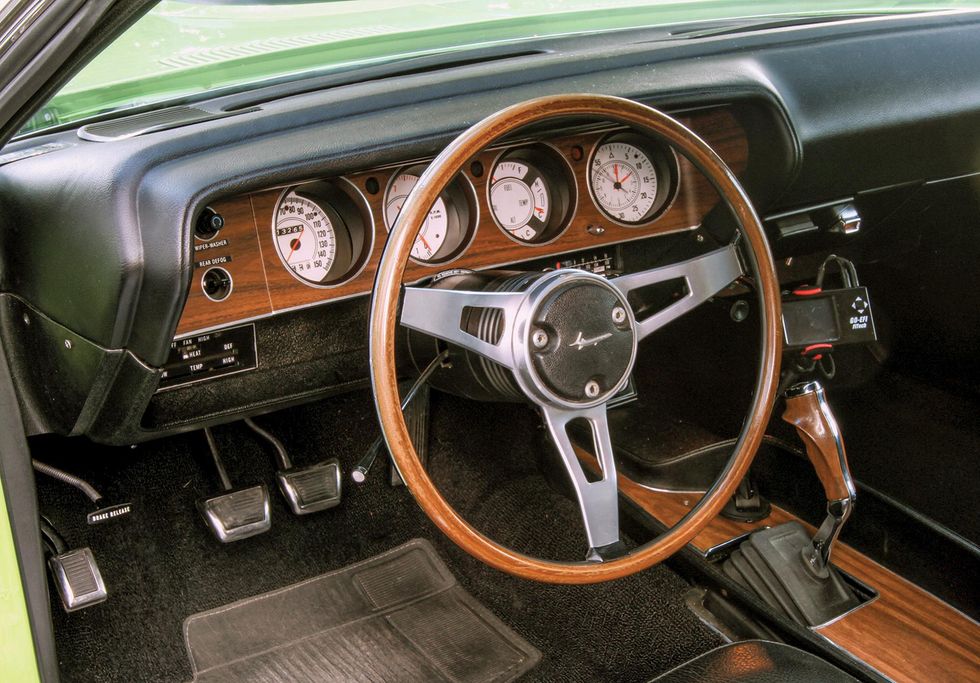
STEERING
Type: Power-assisted recirculating ball
Ratio: 15.7:1
BRAKES
Type: Hydraulic front disc/rear drum with power assist
Front: 10.72-in ventilated disc
Rear: 10 x 2.5-in expanding drum
SUSPENSION
Front: Independent with unequal-length control arms, 0.92-in torsion bars, telescopic shock absorbers and anti-roll bar
Rear: Solid axle located with parallel semi-elliptic multi-leaf springs and telescopic shock absorbers
WHEELS & TIRES
Wheels: Year One Mopar Rallye, aluminum
Front: 17 x 8 in
Rear: 17 x 9 in
Tires: Mickey Thompson radial
Front: 245/45R17
Rear: 275/50R18
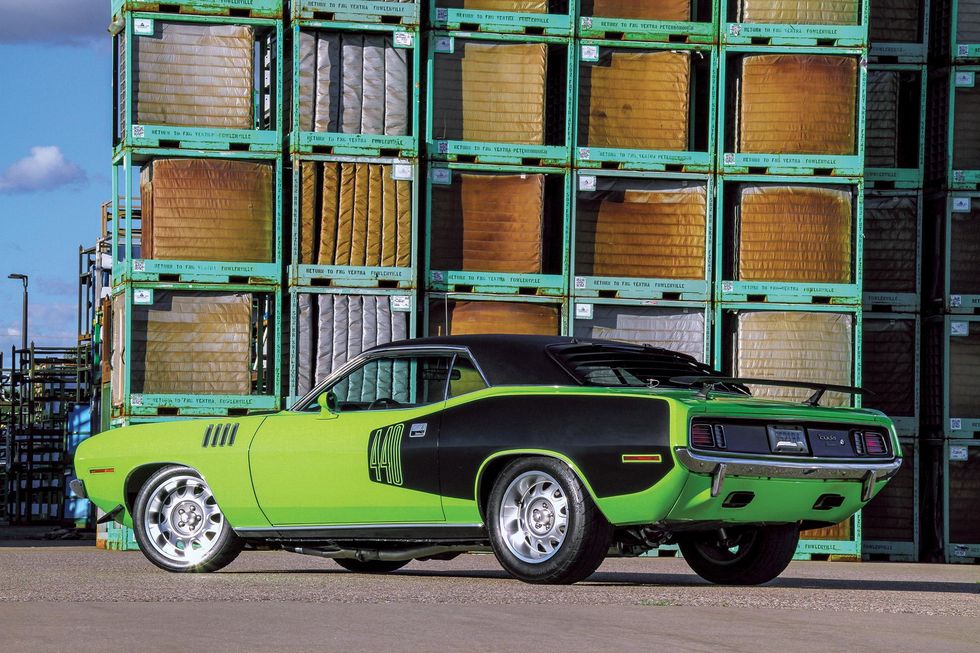
The Chevy Nomad might steal the headlines when it comes to mid-Fifties two-door GM wagons, but Pontiac fans have their own distinctively sporty long-roof model to cheer on. While the bowtie brigade was selling the Nomad, Pontiac offered the Safari, which was built on the same platform as its corporate counterpart.
It doesn’t take much more than a quick glance to see the commonalities between the two cars. A bit longer glance and the Pontiac designs for the body, grille, trim and lighting become a bit more obvious. The Nomad was not produced in particularly large numbers, but the Pontiac version saw even lowers sales. This rare 1957 Pontiac Star Chief Custom Safari station wagon was one of just 1,292 built that year. It’s unknown how many remain, but this one is currently available on Hemmings Auctions, with bids being accepted for only a couple more days.

Like the Nomad, plenty of hot rodders got their hands on two-door Safari wagons. Some of them even cannibalized Pontiacs to resurrect the more-popular Nomads. This ’57 Safari has been customized in multiple ways, starting with the replacement of its original 347-cu.in. V8 with a rebuilt 428-cu.in. powerplant out of a 1968 Bonneville. It is mated to a Strat-Flight Hydra-Matic transmission that has also been rebuilt, according to the seller’s notes.

The shiny purple metallic paint is a far cry from the original two-tone that featured Charcoal Gray as the primary color with Silver Beige complementing it, according to the firewall body tag. Inside, the original leather interior has been replaced with gray cloth upholstery and carpet that works well with the violet exterior. As an original factory-air car, this Safari was already equipped with vents and controls for A/C. Rather than the original equipment, it now is cooled by an aftermarket air-conditioning system. Other upgrades include front disc brakes to help with stopping the truly unique wagon.
The seller is keen to note that the chrome components have been properly rechromed, including the bars and “PONTIAC” lettering on the tailgate, which are typically pitted on these vehicles. The steering wheel looks to be in great shape, as does the dashboard and instrument panel. The installation of the 428 did require the loss of power steering, but the brakes are power assisted.
Head on over to Hemmings Auctions to take a look at this uncommon 1957 Pontiac Star Chief Custom Safari.
Repair2Rev Episode 1: Checking and Repairing the Fuel System on our 1992 Chevrolet Corvette
Sports car shoppers know that bargains are often fraught with challenges. Join our father-daughter team of Dane and Riley as they evaluate the fuel system on a 1992 Chevrolet Corvette. The 4th-gen is referred to as a C4 and the body style extended from 1983 through 1996. With 30-plus years on the clock, time has not been kind to this two-seater. While Riley’s aiming for spirited performance, Dane’s focus is to make sure the car is safe and reliable. How about those tires? The Optispark ignition system? Plus, what’s the impact of ethanol fuels that have passed through the in-tank pump and the submersed rubber fuel lines. Knowledge gained here will help you find your bargain buy without the anxiety of lacking tips to make repairs.
Hemmings is the ultimate destination for finding your perfect ride. Head to Hemmings.com to register and start your search today or download our Hemmings marketplace app for Apple and Android devices.